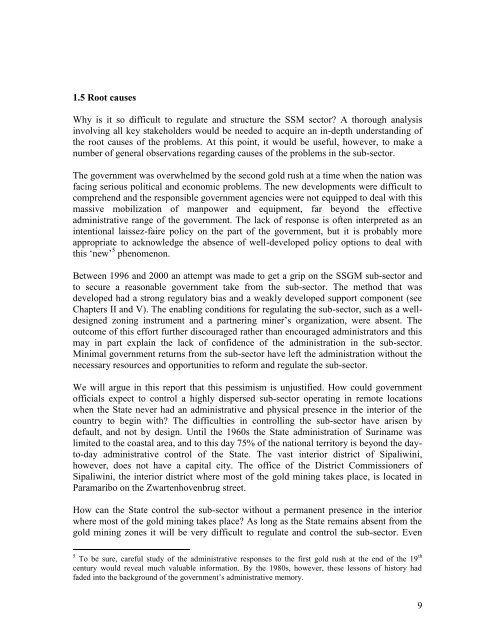SITUATION ANALYSIS OF THE SMALL-SCALE GOLD ... - WWF
SITUATION ANALYSIS OF THE SMALL-SCALE GOLD ... - WWF
SITUATION ANALYSIS OF THE SMALL-SCALE GOLD ... - WWF
Create successful ePaper yourself
Turn your PDF publications into a flip-book with our unique Google optimized e-Paper software.
1.5 Root causes<br />
Why is it so difficult to regulate and structure the SSM sector? A thorough analysis<br />
involving all key stakeholders would be needed to acquire an in-depth understanding of<br />
the root causes of the problems. At this point, it would be useful, however, to make a<br />
number of general observations regarding causes of the problems in the sub-sector.<br />
The government was overwhelmed by the second gold rush at a time when the nation was<br />
facing serious political and economic problems. The new developments were difficult to<br />
comprehend and the responsible government agencies were not equipped to deal with this<br />
massive mobilization of manpower and equipment, far beyond the effective<br />
administrative range of the government. The lack of response is often interpreted as an<br />
intentional laissez-faire policy on the part of the government, but it is probably more<br />
appropriate to acknowledge the absence of well-developed policy options to deal with<br />
this „new‟ 5 phenomenon.<br />
Between 1996 and 2000 an attempt was made to get a grip on the SSGM sub-sector and<br />
to secure a reasonable government take from the sub-sector. The method that was<br />
developed had a strong regulatory bias and a weakly developed support component (see<br />
Chapters II and V). The enabling conditions for regulating the sub-sector, such as a welldesigned<br />
zoning instrument and a partnering miner‟s organization, were absent. The<br />
outcome of this effort further discouraged rather than encouraged administrators and this<br />
may in part explain the lack of confidence of the administration in the sub-sector.<br />
Minimal government returns from the sub-sector have left the administration without the<br />
necessary resources and opportunities to reform and regulate the sub-sector.<br />
We will argue in this report that this pessimism is unjustified. How could government<br />
officials expect to control a highly dispersed sub-sector operating in remote locations<br />
when the State never had an administrative and physical presence in the interior of the<br />
country to begin with? The difficulties in controlling the sub-sector have arisen by<br />
default, and not by design. Until the 1960s the State administration of Suriname was<br />
limited to the coastal area, and to this day 75% of the national territory is beyond the dayto-day<br />
administrative control of the State. The vast interior district of Sipaliwini,<br />
however, does not have a capital city. The office of the District Commissioners of<br />
Sipaliwini, the interior district where most of the gold mining takes place, is located in<br />
Paramaribo on the Zwartenhovenbrug street.<br />
How can the State control the sub-sector without a permanent presence in the interior<br />
where most of the gold mining takes place? As long as the State remains absent from the<br />
gold mining zones it will be very difficult to regulate and control the sub-sector. Even<br />
5 To be sure, careful study of the administrative responses to the first gold rush at the end of the 19 th<br />
century would reveal much valuable information. By the 1980s, however, these lessons of history had<br />
faded into the background of the government‟s administrative memory.<br />
9
















